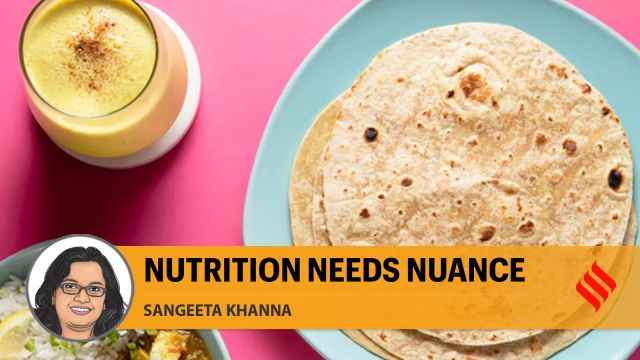
The Indian diet is highly skewed in favour of carbohydrates and the main culprit is our obsession with rice, roti and other grain-based foods that form the core of our thali. This is the message implicit in the recent editorial based on the new study by ICMR in collaboration with the Madras Diabetes Research Foundation (‘Ways of eating’, IE, October 6). It is appalling to see the staples of the country being villainised in one swoop and the real culprits left untouched. Clubbing all sources of carbohydrates together — including whole grains, cereals, refined flours and other refined products like semolina and vermicelli along with cane sugars — to calculate that carbs make up 62 per cent of the total calorie intake of Indians is a grossly faulty method of looking at the average Indian’s daily diet. Note that the study doesn’t even account for consumption of high-fructose corn syrup (HFCS) from soft drinks — whose market is expanding steadily in the country — citing lack of data regarding the same.
A more nuanced insight into consumption patterns can help identify the food groups responsible for the rise of diabetes and cardiovascular diseases in India, especially when food is only half the story. Lifestyle factors like stress, outdoor activities (for better circadian rhythm alignment) and inclusion of biodiverse foods for better gut health are yet to become part of mainstream conversations about immunity and metabolic disorders. It is noteworthy that 61 per cent of the survey participants were sedentary, with an overall 83 per cent reporting at least one metabolic risk factor, defined as the presence of either newly diagnosed Type-2 diabetes, prediabetes, dyslipidaemia, general obesity, abdominal obesity or hypertension.
Per capita consumption of cereal in India has been showing a gradual decline over the last few decades and per capita sugar consumption has been on a steady rise. Per capita monthly cereal consumption has declined significantly from 13.4 kg in rural areas and 10.6 kg in urban areas in 1993-94 to 9.4 kg and 8 kg, respectively, in 2023-24. The annual per capita sugar consumption has increased from 23.7 kg in 2015 to 25.5 kg in 2025. At the same time, a press note by the Ministry of Statistics and Programme Implementation (MoSPI) indicates that in the last two years, total calorie consumption per person per day has increased from 2,233 Kcal to 2,383 Kcal in rural areas and from 2,250 Kcal to 2,472 in urban India.
The problem, it is clear, is overall high calorific intake dominated by sugars and refined carbs, which is meddling with the human metabolism.
Additionally, linking low percentage of protein intake with metabolic diseases in India is a reductionist approach that undermines the importance of the quality of proteins coming from diverse sources. As the ICMR study indicates, a 5 per cent isocaloric replacement of carbohydrates with proteins (plant-based, dairy, poultry and fish) showed 6-10 per cent reduction of newly diagnosed T2D and prediabetes. This reduction in carbs should be by removal of sugars and HFCS and not whole grain-based foods like rice and roti.
Making generalised and misleading conclusions from insufficient research could impact farmers and ecologies in a significant way apart from leading to health hazards. Fuelling the demand for processed plant-based proteins while neglecting the nature-based ways of achieving protein sufficiency would be disastrous. A diet already high in ultra-processed sugars and carbs will start being loaded with ultra-processed poor-quality proteins, leading to more metabolic health problems. Imagine grains not making rotis but HFCS for the soft drinks while their germ and protein residue end up in other ultra-processed foods. Oil from the germ in packaged chips and isolated protein hydrolysates in a protein supplement may work better for profiteering, not human health. The soil and water systems will be decimated while human health is jeopardised for generations to come.
We need a better understanding of the markets, industries, farming and the entire food system to get clarity on how increasing prosperity is impacting consumption patterns and how industries are pushing for cheaper ingredients that make their way to hyper-processed foods. Increased buying capacity enables people to purchase convenience as that’s the only clear achievable goal right now. Nutritional information is so contradictory that it will keep the consumption patterns faulty for a few decades, if not generations, if awareness and appropriate policies are not in place.
The writer is a nutrition and culinary consultant and a permaculturist working in alignment with ecology